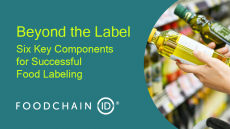Campbell Soup's new labels give wordy ingredients footnotes
The company said the labels on the Select Harvest soups “cleanly and simply” identify exactly what has gone into it, giving a short explanation where needed. An example is maltodextrin, a carbohydrate made from potato or corn starch, which has a definition next to the overall ingredient list.
The packaging for the 44 new soups also highlights ingredients that have been avoided such as MSG (monosodium glutamate), high fructose corn syrup, artificial flavors and hydrogenated oils.
Earlier this year a Nielsen Company global online survey found that nearly two-thirds (65 percent) of US consumers notice nutritional information on food packaging more often now compared to two years ago. And 67 percent claim to “mostly” understand the nutritional information on food packaging.
Nielsen analysts said that an increasing interest in nutritional information in the US could provide opportunities for food and beverage manufactures to use their ingredients as a marketing tool.
In the new range, Campbell boasts of 100 percent natural white meat chicken, pasta made with whole grains and all natural chicken stock.
They have also added lower sodium natural sea salt to help meet the “healthy” sodium level of 480mg per serving.
Colin Watts, general manager, Campbell Soup Company, said: “You can expect more in the way of cleaner, simpler labels and lower sodium products.
“These new soups demonstrate our continued commitment to reducing sodium, with each of the 44 soups meeting the government’s healthy sodium guidelines.”
The product line is designed to meet different tastes, wellness and lifestyle needs. As well as the ‘healthy request’ varieties that meet government guidelines for food, there are ‘light’ varieties which are low in fat, saturated fat and cholesterol and qualify as heart healthy.
The labels are also printed with paper made with 75 percent recyclable fiber content and use soy ink.
However, the company points out that some of the soups contain yeast extract, a natural ingredient with a small amount of naturally occurring monosodium glutamate.
There is an increasing pressure on the food industry to play a greater role in educating consumers about what they’re eating. However, Nielsen said that as so many consumers are taking time to read nutrition labels, there is an opportunity to provide consumer-friendly information on labels that may entice shoppers to switch brands.
An example of how the industry has used a health claim on packaging as a promotion mechanism to appeal to consumers is the 'HFCS-free' boasts.
High fructose corn syrup (HFCS), which has until recently been a popular and common sweetener used especially in beverages, has been found by some studies to be linked to higher body weight.
According to results in September from Datamonitor's Productscan Online, 146 new food and beverage products have been launched that year worldwide proclaiming that they do not contain any high fructose corn syrup (HFCS). This compared to just 54 products that announced they were HFCS-free in 2006.

















